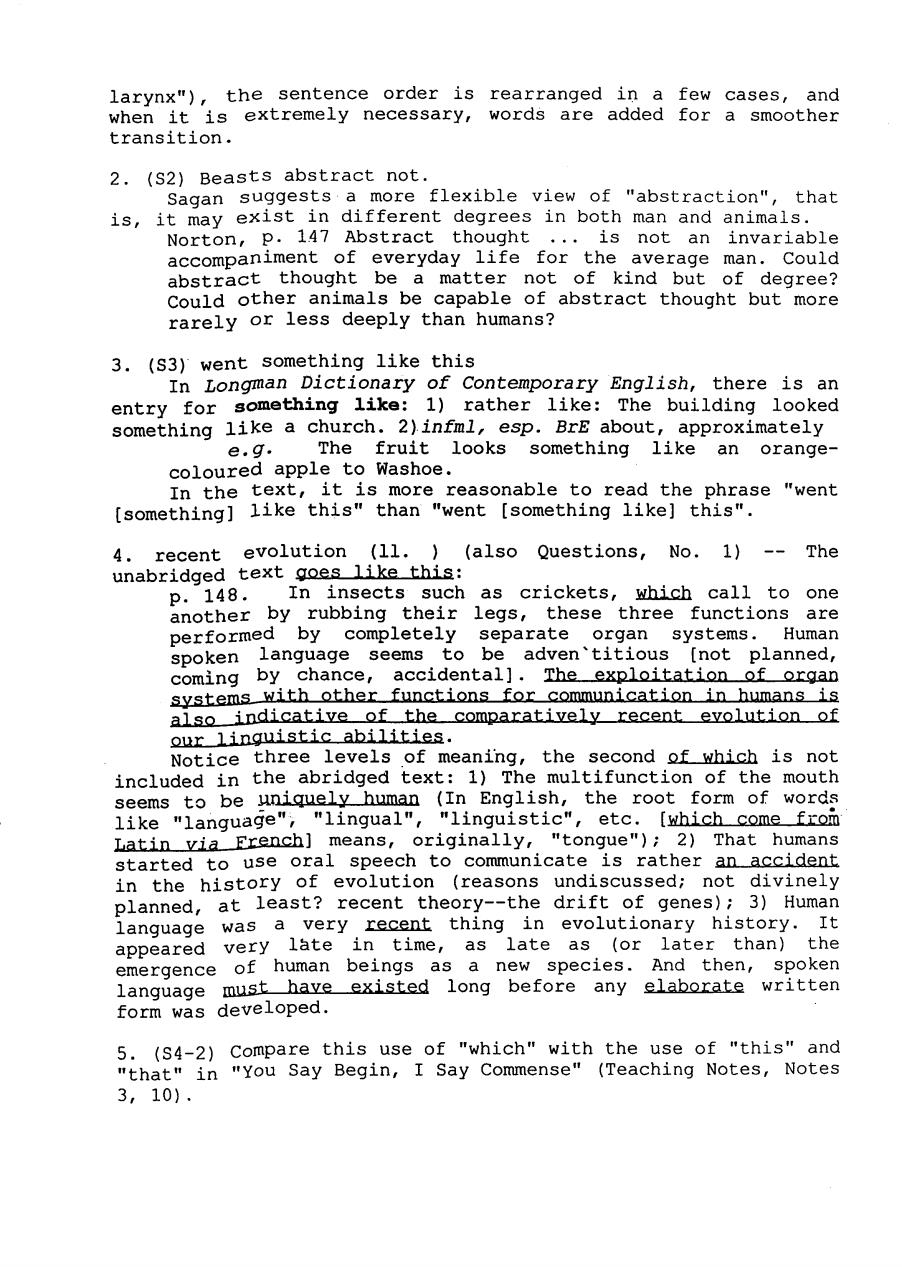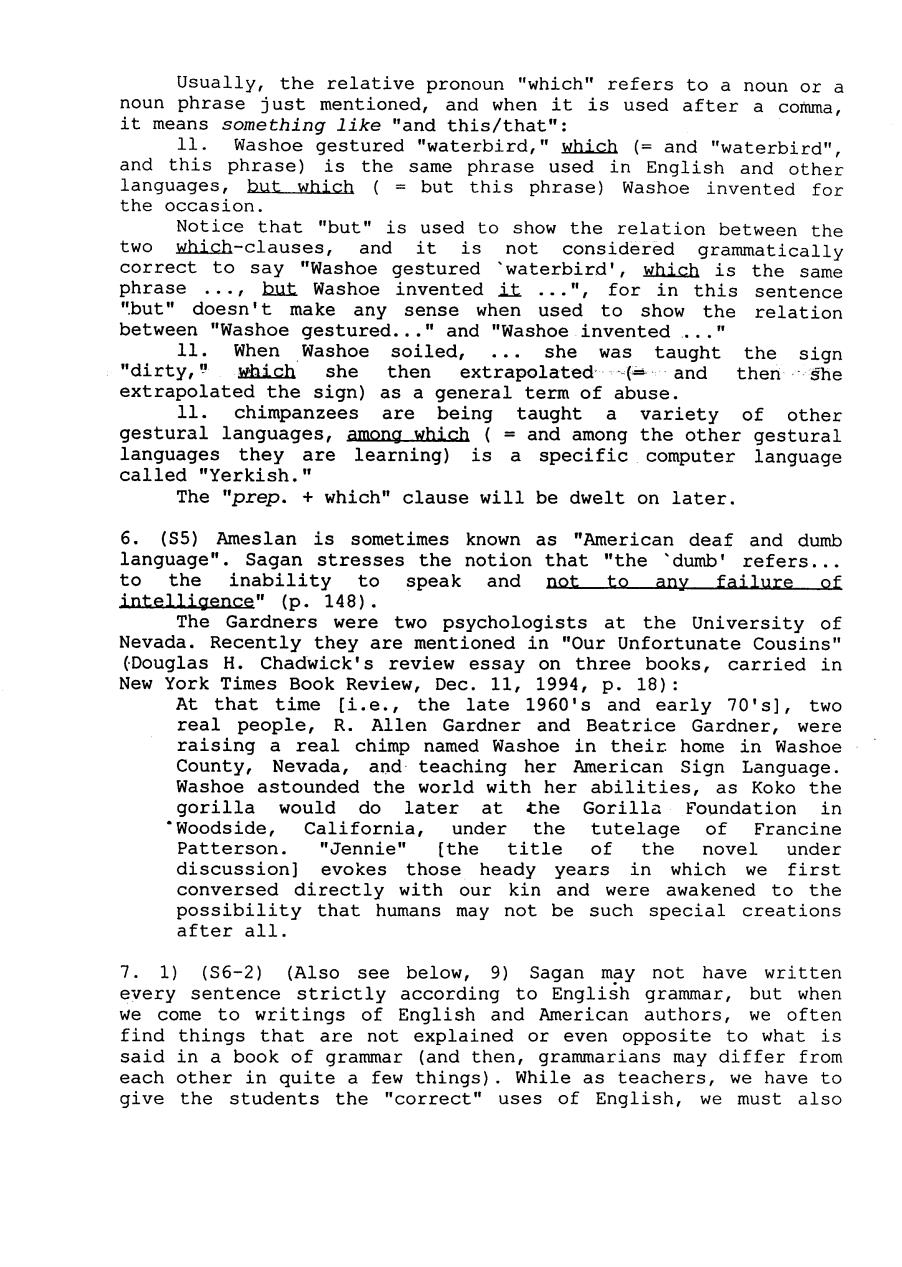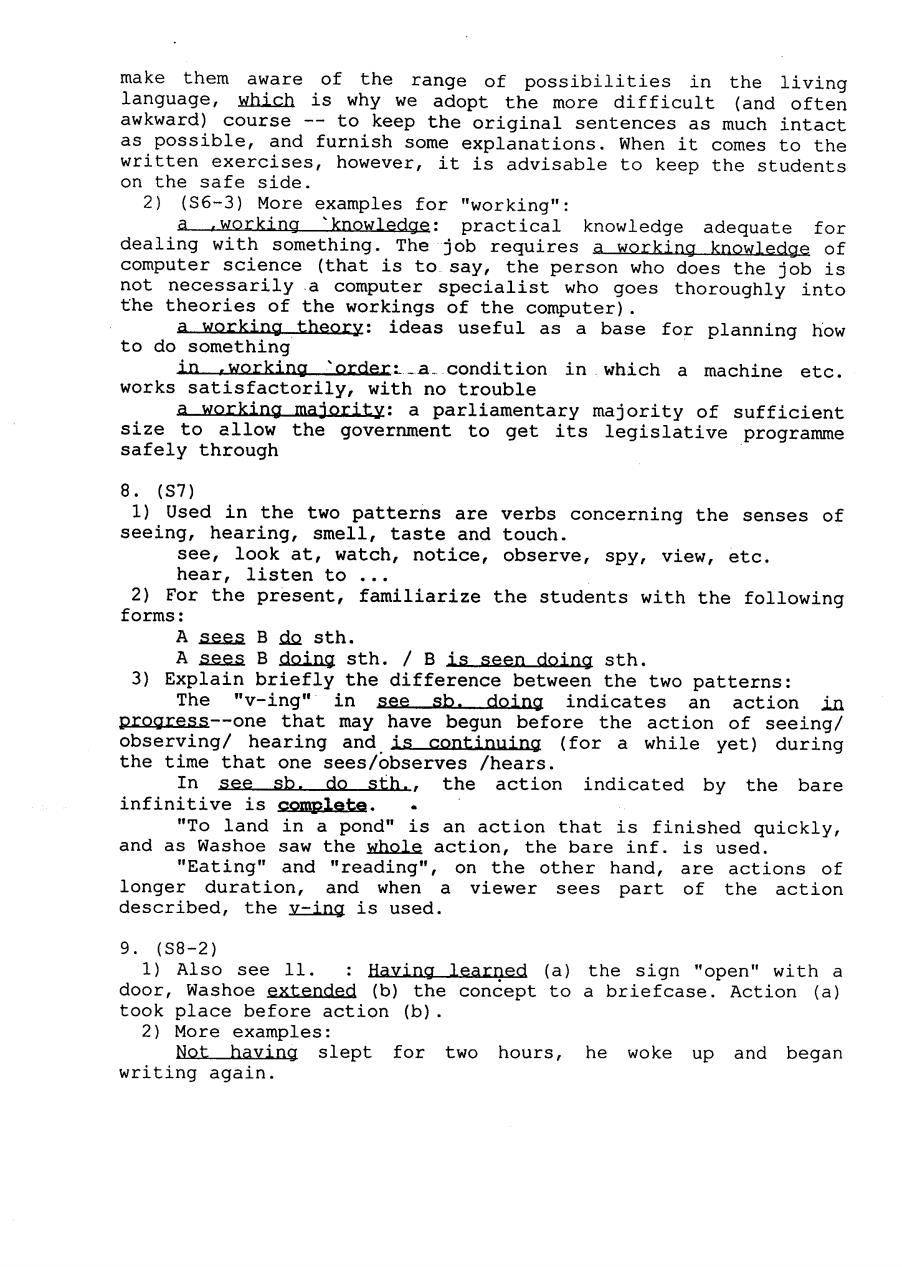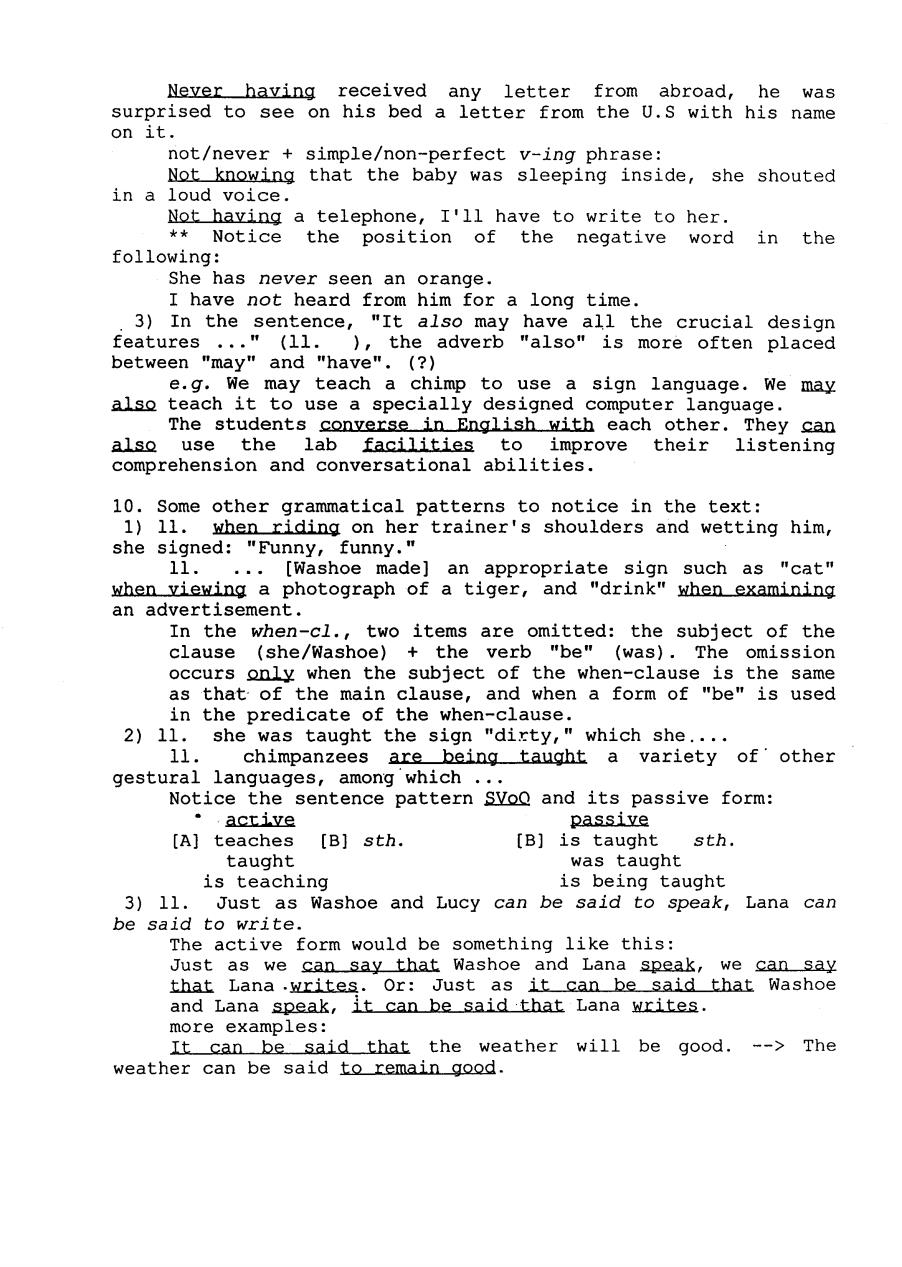
difficulties,or the like;as,the situation demands the exercise of great intelligence;"He thinks the war could have been prevented with a little intelligence"(R.Macaulay). Notes 1.(S1)More about the author,the text and the adaptation: 1)Carl Sagan's works include:The Dragons of Eden,The Cosmic Connection,Intelligent Life in the Universe (with I.S. Shklovsky),Planetary Exploration.His most recent book is The Pale Blue:Vision of the Human Future in Space Headline (1995). Sagan is responsible for the suggestion that algae be used to change the atmosphere of Venus so as to make.it inhabitable. See College English,I,Lesson Nine. 2)Our text is taken from "The Abstractions of Beasts"in The Norton Reader,5th edition,pp.146-154,which is itself an abridged essay from The Dragon of Eden,Random House,1977. 3)About the adaptation: a.Leaving out the major orientation of the original essay so as to make the relations between linguistic (or quasi- linguistic)abilities and intelligence the focus of the present text. In the Norton text,Carl Sagan argues strongly for "animal rights"and extended "ethical perspectives": Norton,p.153 How smart does a chimpanzee have to be before killing him constitutes murder?What further properties must he show before religious missionaries must consider him worthy of attempts at conversion? p.154 [reacting to the echoed shriekings of caged chimps at a large primate/praimeit/.(灵长目)research laboratory] But chimpanzees can abstract.Like other mammals,they are capable of strong emotions.They have certainly committed no crimes.I do not claim to have the answer,but I think it is..certainly worthwhile to rai.se the question:Why, exactly,all over the civilized world,in virtually every major city,are apes in prison? ..The cognitive abilities of the chimpanzees force us 。 to raise searching questions about the boundaries of the community of beings to which special ethical considerations are due,and can,I hope,help to extend our ethical perspectives downward through the taxa[分类,pl.of "taxon",various classes of animals]on Earth and upwards to extraterrestial organisms,if they exist. b.The text is a greatly shortened version:information less crucial to bring out the present focus is.left out, examples of the same type of abstracting power are omitted, technical terms are replaced by more frequently used words and phrases (thus,"anatomy"is used instead of "pharynx and

larynx"),the sentence order is rearranged in a few cases,and when it is extremely necessary,words are added for a smoother transition. 2.(S2)Beasts abstract not. Sagan suggests a more flexible view of "abstraction",that is,it may exist in different degrees in both man and animals. Norton,p.147 Abstract thought...is not an invariable accompaniment of everyday life for the average man.Could abstract thought be a matter not of kind but of degree? Could other animals be capable of abstract thought but more rarely or less deeply than humans? 3.(S3)went something like this In Longman Dictionary of Contemporary English,there is an entry for something like:1)rather like:The building looked something like a church.2)infml,esp.BrE about,approximately e.g.The fruit looks something like an orange- coloured apple to Washoe. In the text,it is more reasonable to read the phrase "went [something]like this"than "went [something like]this". 4.recent evolution (11.)(also Questions,No.1)--The unabridged text goes like this: p.148.In insects such as crickets,which call to one another by rubbing their legs,these three functions are performed by completely separate organ systems.Human spoken language seems to be adven'titious [not planned, coming by chance,accidentall.The exploitation of organ systems with other functions for communication in humans is also indicative of the comparatively recent evolution of our linguistic abilities. Notice three levels of meaning,the second of which is not included in the abridged text:1)The multifunction of the mouth seems to be uniquely human (In English,the root form of words like "language","lingual","linguistic",etc.[which come from Latin via Erench]means,originally,"tongue");2)That humans started to use oral speech to communicate is rather an accident in the history of evolution (reasons undiscussed;not divinely planned,at least?recent theory--the drift of genes);3)Human language was a very recent thing in evolutionary history.It appeared very late in time,as late as (or later than)the emergence of human beings as a new species.And then,spoken language must have existed long before any elaborate written form was developed. 5.(S4-2)Compare this use of "which"with the use of "this"and "that"in "You Say Begin,I Say Commense"(Teaching Notes,Notes 3,10)

Usually,the relative pronoun "which"refers to a noun or a noun phrase just mentioned,and when it is used after a comma, it means something like "and this/that": 11.Washoe gestured "waterbird,"which (and "waterbird", and this phrase)is the same phrase used in English and other languages,but which (but this phrase)Washoe invented for the occasion. Notice that "but"is used to show the relation between the two which-clauses,and it is not considered grammatically correct to say "Washoe gestured 'waterbird',which is the same phrase ...but Washoe invented it...",for in this sentence "but"doesn't make any sense when used to show the relation between "Washoe gestured..."and "Washoe invented..." 11.When Washoe soiled,...she was taught the sign "dirty,which she then extrapolated(=and thenshe extrapolated the sign)as a general term of abuse. 11.chimpanzees are being taught a variety of other gestural languages,among_which (and among the other gestural languages they are learning)is a specific computer language called "Yerkish." The "prep.which"clause will be dwelt on later. 6.(S5)Ameslan is sometimes known as "American deaf and dumb language".Sagan stresses the notion that "the 'dumb'refers... to the inability to speak and not to any failure of intelligence"(p.148). The Gardners were two psychologists at the University of Nevada.Recently they are mentioned in "Our Unfortunate Cousins" (Douglas H.Chadwick's review essay on three books,carried in New York Times Book Review,Dec.11,1994,p.18): At that time [i.e.,the late 1960's and early 70's],two real people,R.Allen Gardner and Beatrice Gardner,were raising a real chimp named Washoe in their home in Washoe County,Nevada,and.teaching her American Sign Language. Washoe astounded the world with her abilities,as Koko the gorilla would do later at the Gorilla Foundation in .Woodside,California,under the tutelage of Francine Patterson."Jennie"[the title of the novel under discussion]evokes those heady years in which we first conversed directly with our kin and were awakened to the possibility that humans may not be such special creations after all. 7.1)(S6-2)(Also see below,9)Sagan may not have written every sentence strictly according to English grammar,but when we come to writings of English and American authors,we often find things that are not explained or even opposite to what is said in a book of grammar (and then,grammarians may differ from each other in quite a few things).While as teachers,we have to give the students the "correct"uses of English,we must also

make them aware of the range of possibilities in the living language,which is why we adopt the more difficult (and often awkward)course --to keep the original sentences as much intact as possible,and furnish some explanations.When it comes to the written exercises,however,it is advisable to keep the students on the safe side. 2)(S6-3)More examples for "working": a workingknowledge:practical knowledge adequate for dealing with something.The job requires a working knowledge of computer science (that is to.say,the person who does the job is not necessarily a computer specialist who goes thoroughly into the theories of the workings of the computer). a working theory:ideas useful as a base for planning how to do something in working order:a.condition in.which a machine etc. works satisfactorily,with no trouble a working majority:a parliamentary majority of sufficient size to allow the government to get its legislative programme safely through 8,(S7) 1)Used in the two patterns are verbs concerning the senses of seeing,hearing,smell,taste and touch. see,look at,watch,notice,observe,spy,view,etc. hear,listen to .. 2)For the present,familiarize the students with the following forms: A sees B do sth. A sees B doing sth./B is seen doing sth. 3)Explain briefly the difference between the two patterns: The "v-ing"in see sb.doing indicates an action in progress--one that may have begun before the action of seeing/ observing/hearing and is continuing (for a while yet)during the time that one sees/observes /hears. In see sb.do sth.,the action indicated by the bare infinitive is complete.. "To land in a pond"is an action that is finished quickly, and as Washoe saw the whole action,the bare inf.is used. "Eating"and "reading",on the other hand,are actions of longer duration,and when a viewer sees part of the action described,the y-ing is used. 9.(S8-2) 1)Also see 11.:Having learned (a)the sign "open"with a door,Washoe extended (b)the concept to a briefcase.Action (a) took place before action (b). 2)More examples: Not having slept for two hours,he woke up and began writing again

Never having received any letter from abroad,he was surprised to see on his bed a letter from the U.S with his name on it. not/never simple/non-perfect v-ing phrase: Not knowing that the baby was sleeping inside,she shouted in a loud voice. Not having a telephone,I'1l have to write to her. *Notice the position of the negative word in the following: She has never seen an orange. I have not heard from him for a long time. 3)In the sentence,"It also may have all the crucial design features ..."(11.)the adverb "also"is more often placed between "may"and "have".(? e.g.We may teach a chimp to use a sign language.We may also teach it to use a specially designed computer language. The students conyerse in English with each other.They can also use the lab facilities to improve their listening comprehension and conversational abilities. 10.Some other grammatical patterns to notice in the text: 1)11.when riding on her trainer's shoulders and wetting him, she signed:"Funny,funny." 11....[Washoe made]an appropriate sign such as "cat" when viewing a photograph of a tiger,and "drink"when examining an advertisement. In the when-cl.,two items are omitted:the subject of the clause (she/Washoe)+the verb "be"(was).The omission occurs only when the subject of the when-clause is the same as that of the main clause,and when a form of "be"is used in the predicate of the when-clause. 2)11.she was taught the sign "dirty,"which she.... 11. chimpanzees are being taught a variety of'other gestural languages,among which .. Notice the sentence pattern SVoQ and its passive form: ··active passive [A]teaches [B]sth. [B]is taught sth. taught was taught is teaching is being taught 3)11.Just as Washoe and Lucy can be said to speak,Lana can be said to write. The active form would be something like this: Just as we can say that Washoe and Lana speak,we can say that Lana.writes.Or:Just as it can be said that Washoe and Lana speak,it can be said that Lana writes. more examples: It can be said that the weather will be good.--The weather can be said to remain good